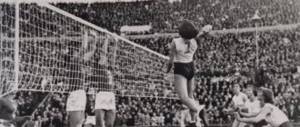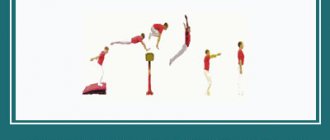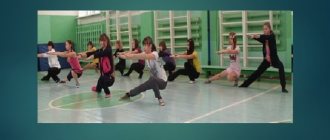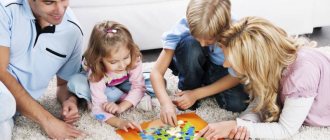Lesson plan for 2nd grade “Circuit training”
Outline of a physical education lesson in 2nd grade on the topic “Circuit training. Outdoor games"
Goals: learn warm-up with gymnastic sticks; conduct circuit training; play an active game.
Formed UUD:
- subject: have an idea of special exercises for maintaining good vision, what circuit training is, be able to climb a gymnastic wall, organize health-saving activities, perform a warm-up with gymnastic sticks and a game exercise for attention;
- meta-subject: accept and maintain the goals and objectives of educational activities, find means of its implementation, plan, control and evaluate educational activities in accordance with the task and the conditions for its implementation, determine the most effective ways to achieve results;
- personal: to be aware of the motives of educational activities and the personal meaning of learning, to show goodwill and emotional and moral responsiveness, to develop the skills of independence and personal responsibility for one’s actions, to follow the attitude towards a safe and healthy lifestyle.
Equipment: stopwatch, whistle, 4-6 flights of gymnastic wall, gymnastic crossbar, gymnastic sticks for each student, 3-5 mats (depending on whether the children will do somersaults and rolls in turns or on two mats at once), gymnastic bench.
During the classes
Introductory part
- Formation in one line. Student report and greeting.
- Announcing the topic and objectives of the lesson.
- A conversation about caring for your eyesight. What exercises should you do to preserve your eyesight? (Children's answers.)
To maintain good vision, you need to do special exercises.
Memo. Eye exercises
- Blink your eyes (1 min).
- Close your eyes and massage your eyelids with the tips of your index fingers in a circular motion.
- Close your eyes tightly, then open them. Repeat 4-5 times.
- If your eyes are very tired from reading, watching TV or working at the computer, it is useful to go to the window and look at the sky for 2-3 minutes.
- Look at the index finger of your hand extended in front of you. Slowly move your finger towards the tip of your nose, continuing to follow it with your eyes. Repeat 4-5 times.
- At home, you can glue a circle of paper to the window. Close one eye and look at the circle with the other for 5 seconds. Then look into the distance. Do the same with the other eye. Repeat 6-8 times.
- Rotate your eyes first to the left and then to the right. Repeat 6-8 times.
- Look up and down, left, right, upper right corner, lower left corner and vice versa. Repeat 6-8 times.
And the main thing is to avoid dangerous situations, protect your eyes from branches in the forest, sharp objects, etc.
All these exercises are given in the textbook. When we introduce or repeat them to students, we do not perform the exercises for a long time, we do them 1-2 times. You can not use all exercises, but only those that you like best.
After the eye exercises, we move on to warming up.
- Walking at a marching pace. Cool, right! March around the hall to the left! Let's march!
- Running without tasks. Run (1 minute), after which students take a step and perform breathing exercises. Walking around the circle, students take one gymnastic stick, stop on the long side of the hall, count on the first or second, line up in two lines and open their arms to the sides.
Warm-up with gymnastic sticks
- I. p. - main stance, stick below. On the count of “one” - stick up, right foot back on the toe; on the count of “two” - return to the starting position; on the count of “three” - stick up, left foot back on the toe; on the count of “four” - return to the starting position. Repeat 4 times.
- I. p. - legs apart, stick below. On the count of “one” - turn your head to the right, stick to the right, with the right end of the stick as if trying to pierce the air; on the count of “two” - turn your head to the left, stick to the left, as if trying to pierce the air with the left end of the stick. Repeat 4 times.
- I. p. - main stance, stick at the top. On the count of “one” - turn the body to the right, stick forward; on the count of “two” - return to the starting position; on the count of “three” - turn the body to the left, stick forward; on the count of “four” - return to the starting position. Repeat 4 times.
- I. p. - legs apart, stick below. Counting to 4 - circular movements with the stick to the right, up, left, down. On the count of “five to eight,” do the same in the other direction. Repeat 4 times.
- I. p. - legs apart, stick below. On the count of “one” - tilt, touch the floor with the stick (those who find it difficult can slightly turn the stick to touch the floor with it); on the count of two - return to the starting position. Repeat 4 times at a slow pace.
- I. p. - main stance, stick below. On the count of “one” - lunge to the right, turn the body to the left, arms forward; on the count of “two” - return to the starting position; on the count of “three” - lunge to the left, turn the body to the right, arms forward; on the count of “four” - return to the starting position. Repeat 4 times.
- I. p. - basic stance, stick in front of feet. On the count of “one” - jump forward over the stick; on the count of “two” - jump over the stick back to the starting position. Repeat 8 times, starting slowly, gradually increasing the pace.
- After jumping, take the sticks in your hands, walk in a circle, put them back in place, walk and sit on the bench.
- Main part
- Circuit training
Circuit training stations depend on many parameters: the number of children, available inventory and equipment, and the tasks being solved. Today we are repeating previously learned elements and exercises. You can always use different simulators. If it is possible to practice barefoot, then this is a big plus, then you can lay out corrugated paths to prevent flat feet, and these paths can become a link between stations or an independent station, so that children can walk along it for a whole minute.
12 stations are proposed, which means that if there are 24 students in a class, then 2 students per station; if there are more children, then the number of stations can be increased. If there are very few children, then you can let them into the station one at a time. To prevent children from getting confused, you can make signs with numbers at each station - this will make it easier for children to navigate at first.
At each station we practice for 1 minute, after which we move in a circle (clockwise). Children begin to do the exercise and finish when given a signal. The order of stations can be changed if the arrangement of inventory and equipment in this order is inconvenient. Exercises should develop different muscle groups, i.e. you cannot give 3 stations in a row on the arms, and then 3 on flexibility, the load needs to change - first on the arms, then on the abs, then on the legs, etc.
Climbing a gymnastic wall (1 flight).
Here you climb to the very top (if possible) and descend back. So for the whole minute. It is advisable not to go down onto the mats.
- Raising the body from a lying position.
- Hanging while standing and hanging with bent arms on the bar.
- Roll forward.
- Climbing from one flight to another (2-4 flights) on a gymnastic wall. Climb low (to the middle, not higher).
- Rolls with a straight body on the mat.
- Squats.
- Headstand (the teacher is here and helps).
- Push-ups (trying today to see how students do with them).
- Walking to the gymnastic bench and back. I. p. - standing facing the bench. On the count of “one” - step onto the bench on the right; on the count of “two” - step onto the bench with your left (stand on the bench); on the count of “three” - step back from the bench to the right; on the count of “four” - step back from the left bench to the starting position.
- From a sitting position, bend over, trying to reach your toes with your fingers.
- Stand on one leg.
- You should try to complete the task within a minute, but this does not mean that you need to perform it with maximum intensity, you need to choose your own pace of completion so that you have enough strength for the whole minute. It's better to go slowly for a minute than to get tired in the first 10 seconds and then rest.
The teacher explains and shows all the stations, the students go to their places.
- Always watch what the person you are following is doing, so that later there are no questions “what to do now?”
Circular training is carried out (13-15 minutes).
- Outdoor game “Hurry up to clean up”
After the circular training, the students form a circle around the teacher, and an active game for reaction and attention is played, “Hurry up to clean up.” Task: students stretch their arms forward, palms up, the teacher walks in a circle and tries to insult someone, that is, touch an open palm. To avoid this, children try to have time to remove their hands (lower or move back).
III. Final part
- Alignment. The class forms in one line 2-3 minutes before the end of the lesson.
- Summing up the lesson. The teacher briefly sums it up.
- Assessing student work. Praise children for good performance.
- Homework. Remember the text “Take care of your eyesight!” us. 39 textbook.
Summary of physical education lesson “High jump from a straight run”
Summary of lesson No. 2 on basketball in 5th grade







